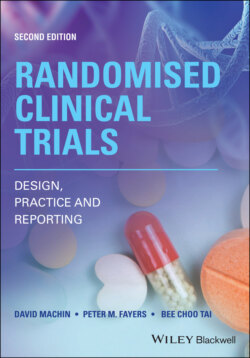Читать книгу Randomised Clinical Trials - David Machin - Страница 69
2.10.4 Randomisation
ОглавлениеIn essence, one purpose of any experiment is to estimate the parameters of a statistical model analogous to that of Equation (2.1). Thus, we conduct a trial in order to collect data with this purpose in mind. We would like to believe that the estimates we obtain in some way reflect the true or population parameter values. In principle, if we repeated the study many times, then we would anticipate that these estimates would form a distribution that is centred on the true parameter value. If this is the case, our method of estimation is unbiased. For example, in a clinical trial comparing two treatments, the parameter βTreat corresponds to the true difference (if any) in efficacy between them, and the object of the trial is to obtain an unbiased estimate of this. The method of selecting which of the eligible patients is to be included in the trial does not affect this, but the way in which those patients who are recruited to the trial are then allocated to which particular treatment does. As we discussed in Chapter 1, of fundamental importance to the design of any clinical trial is the random allocation of subjects to the alternative treatments. Randomisation also provides a sound basis for the ensuing hypothesis testing by the use of statistical tests of significance.
